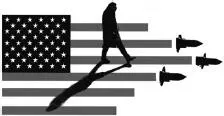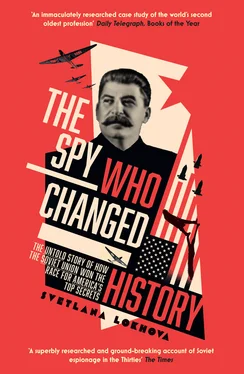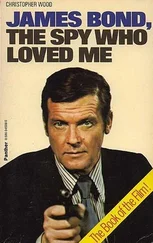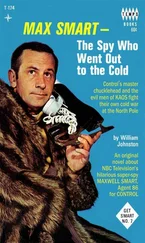• • •
If the trail-blazer Shumovsky had not discovered the usefulness of an MIT education, there would have been no Ethel and Julius Rosenberg, no Klaus Fuchs; fn6the world we know today would be a very different place. To an extent that has never been acknowledged before, the Soviet Union’s survival during the Second World War was underpinned by the technological and manufacturing secrets, plundered from US universities and factories, that enabled the development and mass manufacture of the aircraft and tanks needed to defeat the Third Reich.
Yet Shumovsky is virtually unknown outside Russian intelligence circles. His service records remain classified. Paradoxically, it is his very obscurity that demonstrates most comprehensively his success: we inevitably know most about the spies who were caught or turned traitor. In 2002, on the centenary of his birth, Shumovsky’s biography was published in Russia by MFTI (the Moscow Institute of Physics and Technology), the university that he helped found in 1946. It celebrated his life and achievements as a scientist and educator. 15But there was a thorny problem to skate around: how to explain in an article that the founder of this prestigious place of learning was one of Russia’s greatest spies. The Institute admitted they had few biographical details of Shumovsky’s earlier career to rely on as he had worked there later in his life. Yet the Journal of Applied Mathematics and Technical Physics was able to publish a very warm but anonymously authored biographical sketch of him. Out of respect, and from a desire for completeness, the Institute turned to an unusual source for more information. As the Journal stated euphemistically, ‘for reasons which, on the basis of the text, we can only guess at, the authors have concealed their names under the collective pseudonym “Colleagues and numerous scientific school pupils of S. A. Shumovsky”.’ 16The contributors were in fact his friends and colleagues from the intelligence service, who had access to Shumovsky’s still-classified personnel file. To remove all doubt as to their identity, the anonymous contributors added a footnote to the article that says: ‘It is no coincidence that the portrait of Stanislav Antonovich Shumovsky was placed in the “Hall of Fame” Memorial Museum of the SVR [Foreign Intelligence Service] at Yasenevo.’ 17
Only the employees of the Russian secret service are allowed inside the Hall of Fame. This is as close as Shumovsky has ever come to an official recognition by Moscow of his achievements as a spy. fn7
Stanislav Shumovsky is known rightly as one of the fathers of Russian aviation. This is the first full account of the unusual and surprising methods that he used to achieve his personal dreams and the goals of the Soviet Union.

1
‘SON OF THE WORKING PEOPLE’
Joining fn1an exhilarated crowd heading back to Moscow from Tushino airfield and thrilled by the successful parade of new Soviet air power, Stanislav Shumovsky reflected on his extraordinary life. His mind drifted to the very first time he had seen a man fly, in his home city of Kharkov where he had stood as an eight-year-old in another large crowd, gripping his father’s hand tightly with excitement. It was the summer of 1910 and, just like the rest of the vast Russian Empire, the young Shumovsky had caught aviation fever.
A year before, Shumovsky had clipped from the newspaper a picture of his lifetime hero, the French aviator Louis Blériot, taken after his epic flight across the English Channel. fn2The news announced an era of daring long-distance flight. For the sprawling Romanov domain, now covering over a sixth of the world’s land surface from the frontiers of Europe to the Far East, powered flight opened a world of new possibilities. Shumovsky also saved a newspaper clipping from the same year of the now-forgotten Dutchman who had been the first to pilot a flimsy plane from Russian soil. Unfortunately, he managed just a few hundred yards, but even this meagre feat enraptured the nation. The next summer, Shumovsky’s clippings book bulged with articles showing, to the delight of vast crowds, intrepid Russians fn3climbing aboard imported aircraft to ascend a short, noisy distance into the sky. Everyone, but especially Shumovsky, wanted to see with their own eyes these miraculous machines and the heroes who flew them. Now, finally, it was Kharkov’s turn. Determined not to miss the event, Shumovsky had made his father promise weeks before that they would go together.
The day was set to become a landmark event in his life. For the last week, the local newspapers had been posting on the boards outside their offices stories designed to whip up excitement to see the new triumph of science. A French-designed, but Russian-built Farman IV had finally come to town. The early plane with its many wings looked to the sceptical eyes of the crowd more like an oversized kite, yet somehow the wheezy engine of this ungainly, flimsy jumble of pine, fabric and wire was capable of propelling the pilot and his nervous passenger into the sky. The crowd held its breath and after an uneven and uncomfortable take-off, the plane lifted from the ground, then turned slowly to the left to circle the field before attempting an even bumpier landing. Shumovsky pulled at his father’s hand to be allowed to join those chasing after the landing aircraft, eager to congratulate the pilot and his passenger, and to see up close this conqueror of gravity. The flight had lasted only a few minutes but its impact on Shumovsky was to last a lifetime. It fired a passion for aviation: he wanted to become a pilot.
Stanislav Shumovsky was born on 9 May 1902, 1the eldest of four sons of Adam Vikentevich Shumovsky and his wife, Amalia Fominichna ( née Kaminskaya). His parents were not ethnic Russians but Poles. The family treasured their traditions, practising Catholicism and speaking Polish at home. 2Shumovsky belonged to an old noble family dedicated to public service. According to family legend, the Shumovskys had moved to Poland from Lithuania about six hundred years before with the conquering King Jagiello. 3The Polish government commissioned a statue of this long-forgotten king for their display at the 1939 New York World’s Fair. fn4(The prize-winning Soviet stand, adorned with statues of Lenin and Stalin, in contrast boasted a full-scale model of a Moscow metro station.) 4Since the family move, successive generations of Shumovskys had valiantly served first the Commonwealth of Poland and Lithuania and now the twin-headed Russian eagle. 5
Shumovsky’s father was an accountant and bank official working for the Tsar’s State Treasury in the thriving commercial city of Kharkov. His mother Amalia was born a noble. Her own father was the manager of the large estates of the noted Polish Prince Roman Damian Sanguszko in nearby Volyn province. Amalia was a talented pianist 6and ensured her boys spoke French and German. 7As was expected among the tiny professional class of the time, family life revolved around musical and literary evenings where their mother would showcase her talent. The youngest of the Shumovsky boys, Theodore, recalled a vivid memory of their genteel, comfortable life. He described in his autobiography (appropriately, as events turned out, entitled The Light from the East ) ‘a large room with two windows; in the space between the windows stood a piano, that my mother plays. Her face, framed by her wavy black hair and her eyes focused far away, as always happens, when one surrenders to music.’ 8Theodore grew up to become a dissident academic and today is celebrated in Russia while his elder brother Stanislav, who devoted his entire life to building the Soviet Union, is almost forgotten. fn5
Читать дальше













